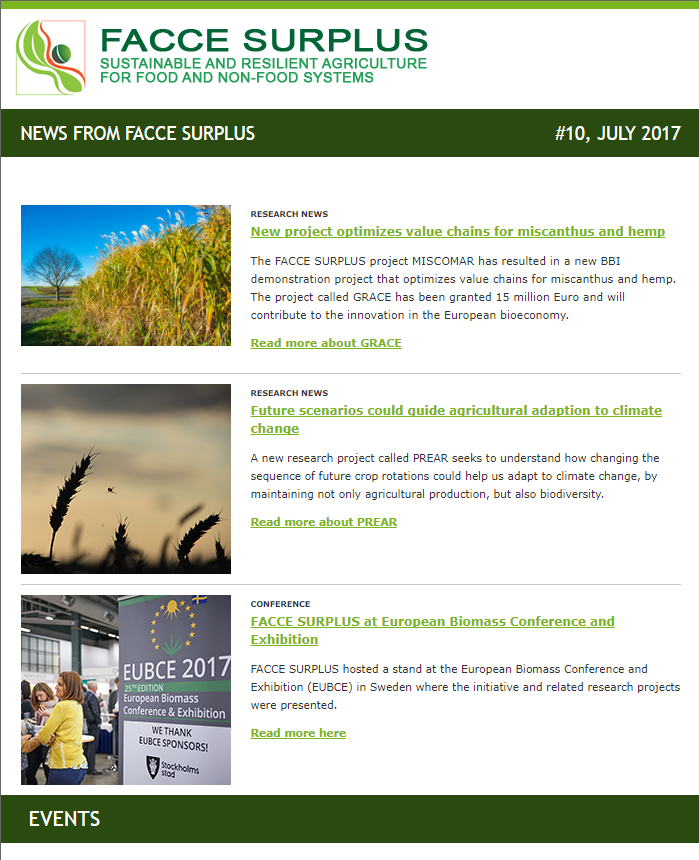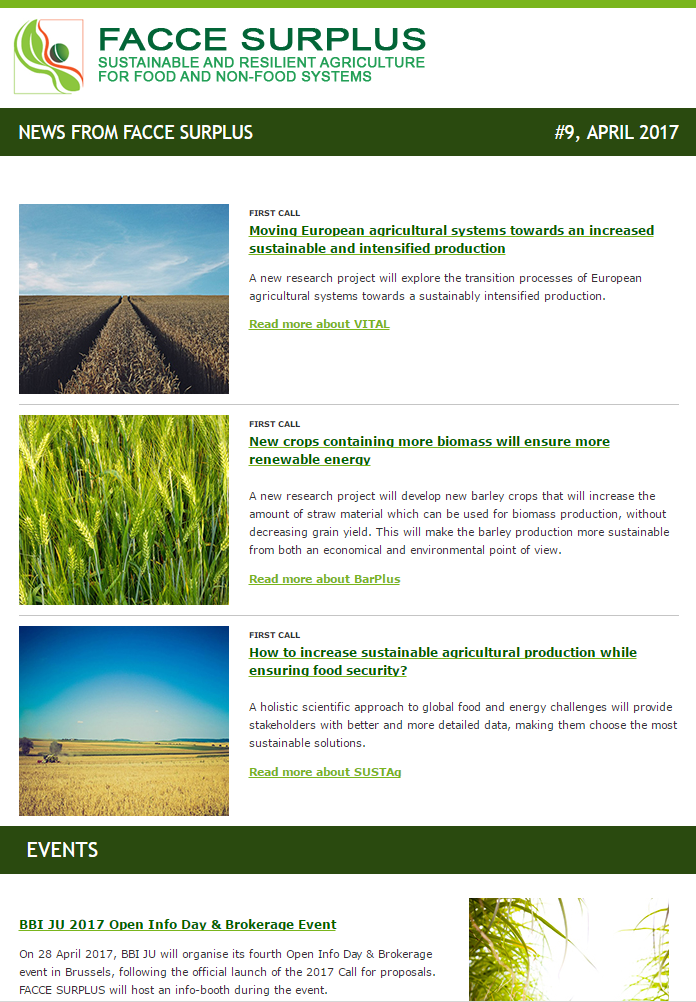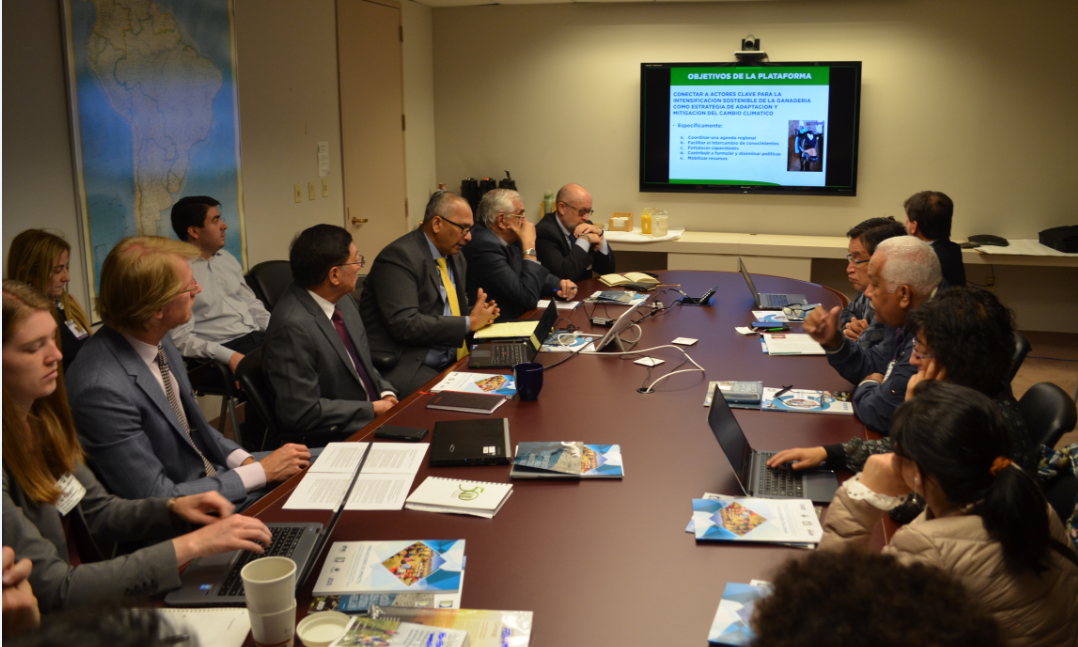The Organisation for Economic Co-operation and Development (OECD) – through its Co-operative Research Programme (CRP) – has opened a call for applications to fund travelling research fellowships and to sponsor international conferences (such as workshops, congresses and symposia) on cutting edge issues in agriculture, food, fisheries and forestry in 2018. The CRP operates under three themes – Managing Natural Capital for the Future, Managing Risks in a Connected World, Transformational Technologies and Innovation. More information, including full details of the application process and selection criteria for both the fellowships and conference support, is available on the website: www.oecd.org/agriculture/crp
The July edition of the FACCE-SURPLUS Newsletter is now available.
The Global Research Alliance is delighted to announce our newest Member country, Zimbabwe. Zimbabwe is the fifth African country to join the Alliance.
Zimbabwe recognises that membership in the Alliance can help the country realise its food security issues and its Nationally Determined Contributions (NDC) targets, enshrined in the Paris Agreement.
The 48 member countries now participating in the activities of the Global Research Alliance are Argentina, Australia, Belgium, Bolivia, Brazil, Canada, Chile, China, Colombia, Costa Rica, Denmark, Dominican Republic, Ecuador, Egypt, Finland, France, Germany, Ghana, Honduras, Indonesia, Italy, Ireland, Japan, Lithuania, Malaysia, Mexico, Nicaragua, the Netherlands, New Zealand, Norway, Panama, Paraguay, Peru, the Philippines, Poland, Republic of Korea, South Africa, Spain, Sri Lanka, Sweden, Switzerland, Thailand, the United Kingdom, Tunisia, the United States, Uruguay, Vietnam and Zimbabwe.
For more information on the GRA or how to become a member country please contact the GRA Secretariat.
The Global Research Alliance has updated its website to include individual pages for the Networks associated with each Research Group. We’ve also freshened up the visuals on the site, created a searchable library, and made space for special highlights of our work. Sample the Livestock Research Group page
Ten research projects on monitoring and mitigating greenhouse gases from agri- and silvi-culture have been selected to receive funding from the FACCE ERA-GAS Co-fund. The projects fall within the scientific scope of the call for proposals, which is divided in the following four research themes:
1) Improving national GHG inventories and monitoring, reporting, and verification of emissions
2) Refining and facilitating the implementation of GHG mitigation technologies
3) State-of-the-art production systems that are profitable and improve food and forest biomass production while reducing GHG emissions
4) Assessment of policy and economic measures to support emissions reductions across the farm-to- fork and forest-to consumer chain
On 4 March 2016 FACCE ERA-GAS launched this co-funded call for transnational research projects on monitoring and mitigation of greenhouse gases from agri- and silvi-culture, in Europe and New Zealand. The call closed on 19 December 2016. In May 2017, following peer review evaluation by a panel of international experts, ten projects were selected. The projects will receive funding from partners from 13 European countries and New-Zealand, with co-funding from the European Commission. The total requested funding is 14.123.000 euro. The evaluation outcomes have been communicated to the project coordinators on 18 May 2017. The projects are expected to start from August 2017.
The Forum of the Future is organising a Feed Compass for the Protein Challenge 2040. A multi-stakeholder group is creating a set of criteria and an easy-to-use tool to help compare different types of feed, with the long-term goals of helping to produce sustainable feed, future-proof value chains, and ensure food security.
https://medium.com/@FuturesCentre/which-animal-feeds-are-fit-for-the-future-881c293cb9b
The Compass will build from current work done in the feed space, including the LEAP Feed Guidelines, and will involve organisations such as the Ahold Delhaize, Calysta, Evonik, Food & Agriculture Organisation (FAO), FEFAC, Forum for the Future, Volac, Waitrose, and WWF-US.
For more information about this initiative, please contact [email protected]
The April edition of the FACCE-SURPLUS Newsletter is now available. This edition includes information on a research project to develop new barley crops with increased straw material and biomass production, without decreased grain yield.
The May edition of the our Partner FACCE-JPI’s newsletter is now available. This edition includes details of their new projects brochure, as well as updates on research, calls for proposals, and meetings and events.
The Joint Programming Initiative on Agriculture, Food Security and Climate Change (FACCE-JPI) tackles the grand societal challenges related to sustainable agricultural development and food security in the face of climate change.
The Global Research Alliance and its Croplands Research Group is pleased to announce that a third Co-Chair has joined the leadership of the Croplands Research Group.
Dr Rosa Mosquera Losada is from the University of Santiago de Compostela, Spain. She joins the current Croplands Research Group Chairs, USA’s Jane Johnson, from the United States’ Agricultural Research Service; and Brazil’s Renato Rodrigues and Ladislau Martin-Leto, both from the Brazilian Agricultural Research Corporation.
During the meeting, topics of common interest were identified in the countries to establish a coordinated research agenda. Prioritized the design of a three-year action plan and the communication strategy and knowledge management that will accumulate the platform. The platform will also work to mobilize resources for research and innovation, as well as identify initiatives and ongoing projects of participating institutions with promising results that can be replicated. The platform will be open to the incorporation of new actors from the private sector and NGOs working on the issue.
The main objective of the platform is to establish alliances with key audiences to intensify livestock production systems in a sustainable manner, such as a regional research strategy to adapt and mitigate the effects of climate change in LAC. The platform will coordinate a regional agenda on the subject and share knowledge and strengthen the capacities of farmers and key audiences in the public and private sector on the issue.
Fundamentally, the platform will collaborate with the formulation and dissemination of policies and the mobilization of resources. The beneficiaries of this project are more than 150 researchers, 400 extensionists and professionals, more than 1000 graduate students, and in the course of university degrees in animal production, veterinary and soil, among others, and more than 10 producer organizations, as well as Decision-makers at national and regional public policy levels.
The platform is initially funded by funds from the agreement between FONTAGRO and MPI to build capacity in the area of GHG measurement in Latin America’s agricultural systems and a project on “Technology Transfer Mechanisms and Climate Networks In LAC, “executed by FONTAGRO and financed by the Global Environment Facility (GEF) and the Inter-American Development Bank (IDB).
The call from our Partner, FONTAGRO, will fund up to US $ 1.2 million in projects to support innovations that meet the growing demand for food without affecting natural resources.
“Innovations for the sustainable intensification of family agriculture in the face of climate change . “
CONTEXT
In the coming decades, one of the greatest challenges facing mankind is how to meet the growing needs of the population in terms of food demand, by increasing the productivity of farming systems in the face of climate change, without affecting natural resources. In that sense, FONTAGRO has decided to promote the development of innovations that promote the sustainable intensification of agriculture and thus contribute to the sustainable production of food with less impact on the environment, especially on soil and water.
FINANCING
The call is made with FONTAGRO’s own resources and will finance up to 4 projects for a total amount of US $ 1.2 million, to support innovation platforms constituted by public and private agents from two or more member countries that work from Coordinated way, also contributing counterpart funds.
The 2017 Call is one of the operating mechanisms of FONTAGRO to support the research and innovation of family agriculture. In this case, the call is aimed at encouraging the development of projects to intensify agricultural production systems in a sustainable way, not only ensuring the natural resource base but also improving them for future generations.
EXAMPLES
Some successful projects co-financed and / or recognized by FONTAGRO in previous calls and contests on intensification are:
i. Harvesting water: The grail of eco-efficient agriculture .
Ii. Adapta Sertão: Adaptation to climate change in the hands of the community .
Iii. Towards a productive and friendly environment .
Iv. Feeding people and the planet: Maize cultivation in partnership with Inga edulis in Ixcán, Guatemala. (Page 195)
The closure for profiling is June 30, 2017 at 1 PM Eastern Time.
For more information on the 2017 Call please visit here
For frequently asked questions on calls access here
For inquiries: [email protected]
****
ABOUT FONTAGRO
FONTAGRO is a unique mechanism of regional cooperation that promotes the innovation of family agriculture, competitiveness and food security. It was created in 1998 and is made up of fifteen member countries that have contributed with capital close to US $ 100 million. It is sponsored by the Inter-American Development Bank (IDB) and the Inter-American Institute for Cooperation on Agriculture (IICA). Its Technical Administrative Secretariat is located at the IDB’s offices in Washington, DC FONTAGRO has cofinanced more than 100 projects and initiatives to its member countries for an approximate amount of US $ 88.7 million, including contributions from other funders and executing institutions. The countries that compose it are Argentina, Bolivia, Chile, Colombia, Costa Rica, Ecuador, Spain, Honduras, Nicaragua, Panama, Paraguay, Peru, Dominican Republic, Uruguay and Venezuela.
We are delighted to announce that the Intergovernmental Panel on Climate Change (IPCC) Panel has accredited the Global Research Alliance on Agricultural Greenhouse Gases as one of their official observer organisations.
The IPCC is the international body for assessing the science related to climate change. It was set up in 1988 by the World Meteorological Organization (WMO) and United Nations Environment Programme (UNEP) to provide policymakers with regular assessments of the scientific basis of climate change, its impacts and future risks, and options for adaptation and mitigation.











